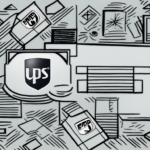Comparing Post Office and UPS Shipping Rates
If you frequently send packages or ship merchandise, having a clear understanding of the different shipping options offered by the United States Postal Service (USPS) and United Parcel Service (UPS) is crucial. Shipping costs play a significant role in your decision-making process, and comparing rates can be challenging due to the vast amount of information available. In this article, we provide a comprehensive comparison of USPS and UPS shipping rates, services, and other factors to help you make an informed decision.
Understanding the Different Shipping Options Offered by USPS and UPS
USPS and UPS offer a variety of shipping options to accommodate different package sizes, delivery times, and budget constraints. Below are the primary services each carrier provides:
USPS Shipping Options
- Priority Mail: Delivers in 1-3 business days with tracking and insurance included.
- First-Class Mail: Ideal for lightweight packages up to 15.999 ounces, with affordable rates.
- Retail Ground: Suitable for larger or heavier packages that are not time-sensitive.
- Media Mail: Cost-effective shipping for educational materials, books, and media items.
- Priority Mail Express: Guaranteed overnight delivery to most locations with tracking and insurance.
UPS Shipping Options
- UPS Ground: Reliable delivery within 1-5 business days, depending on distance.
- UPS Air: Includes services like UPS Next Day Air, UPS 2nd Day Air, and UPS 3 Day Select for faster deliveries.
- UPS International: Extensive global shipping options with customs brokerage services.
- Specialized Services: Includes UPS 2nd Day Air, UPS Express Saver, and UPS Worldwide Saver.
When choosing between USPS and UPS, it's important to consider the destination of your package. While both services offer domestic and international shipping, UPS boasts a larger global network and may be a better option for international shipments. Additionally, UPS provides a variety of customs brokerage services to help navigate international shipping regulations.
Another factor to consider is the level of tracking and insurance offered by each service. USPS offers tracking and insurance for all Priority Mail and Priority Mail Express shipments, while UPS provides tracking and insurance for all shipments. If you're shipping valuable or fragile items, UPS may be a better option for the added insurance and tracking capabilities.
Factors That Influence Shipping Rates: Weight, Distance, and Package Size
The shipping rates for both USPS and UPS are determined by several factors, including package weight, destination, dimensions, and the chosen shipping option. These factors contribute to the complexity of shipping rate structures. Generally, packages with heavier weight, longer distances, and larger dimensions will cost more to ship. Therefore, it’s recommended to weigh, measure, and compare the rates between USPS and UPS to determine the most suitable option for your package.
Another factor that can influence shipping rates is the type of item being shipped. Some items, such as hazardous materials or fragile items, may require special handling or packaging, which can increase the cost of shipping. Additionally, the value of the item being shipped may also affect the shipping rate, as some carriers offer insurance options for high-value items.
It’s also important to consider the timing of your shipment. Shipping during peak seasons, such as holidays or major events, may result in higher rates due to increased demand. Conversely, shipping during off-peak times may result in lower rates and faster delivery times.
How to Calculate Shipping Costs for USPS and UPS
Both USPS and UPS offer shipping rate calculators on their websites that allow you to easily estimate the cost based on package weight, shipping address, and delivery time. You can also visit their respective websites for detailed pricing information and shipping rates for any service you’re considering.
It's important to note that shipping costs can vary depending on the size and weight of your package, as well as the distance it needs to travel. To ensure you're getting the best rate possible, consider using a shipping comparison tool that allows you to compare rates from multiple carriers at once.
Another factor to consider when calculating shipping costs is the type of service you need. For example, if you require expedited shipping or additional insurance, this will likely increase the overall cost. Be sure to carefully review all available options and their associated costs before making a final decision.
The Pros and Cons of Using USPS for Shipping
There are several benefits associated with using USPS for shipping packages:
- Lower Rates for Light Packages: USPS generally offers more affordable rates for lighter packages compared to other carriers.
- Extensive Delivery Network: USPS delivers mail and packages to every address in the U.S., including remote and rural areas.
- Wide Range of Shipping Options: Services such as Priority Mail, First-Class Mail, and Media Mail cater to different shipping needs and budgets.
- Free Shipping Supplies: USPS provides free boxes and envelopes, helping to save on packaging costs.
However, there are some limitations and drawbacks:
- Slower Delivery Times: Cheaper shipping options like Retail Ground may have longer delivery times.
- Limited Tracking Capabilities: While tracking is available, it may not be as detailed or accurate as other shipping carriers.
- Higher Rates for Large or Heavy Packages: Shipping large or heavy items can be more expensive compared to carriers like FedEx or UPS.
The Pros and Cons of Using UPS for Shipping
Using UPS provides unique benefits for both personal and business use:
- Fast and Reliable Shipping: UPS offers a range of expedited shipping options with guaranteed delivery times.
- Specialized Services: Services like UPS My Choice provide enhanced delivery tracking and electronic signature options.
- Extensive Network of Drop-Off Locations: UPS drop-off points are conveniently located in many grocery stores and pharmacies.
However, there are some potential downsides:
- Higher Costs: UPS services can be more expensive compared to USPS, especially for lighter packages.
- Strict Package Size and Weight Restrictions: Shipping large or heavy items may require using different services or paying extra fees.
- Occasional Delivery Issues: Some customers have reported lost or delayed packages, although this is not a common occurrence.
What Services Are Included in USPS and UPS Shipping Rates?
The shipping rates of both USPS and UPS are inclusive of various services such as real-time tracking, insurance, and delivery confirmation. However, both also offer additional options for additional fees, such as signature confirmation or faster delivery times.
The specific services included in the shipping rates may vary depending on the type of shipment and destination. For example, international shipments may have different services included than domestic shipments. Additionally, some services may only be available for certain types of packages or delivery methods. It is always recommended to review the specific details of the shipping options before selecting a service to ensure that it meets your needs and budget.
Comparing the Delivery Timeframes of USPS and UPS
Both USPS and UPS offer delivery estimates based on the selected shipping options, destination, distance, and package size. Generally, USPS takes a bit longer for cheaper options such as Retail Ground or Priority Mail, while the UPS Ground option delivers faster on average, but at a higher cost. It's important to compare the estimated delivery timeframes before making a choice.
Another factor to consider is the location of their distribution centers. UPS has a larger network of distribution centers, which allows for faster delivery times in certain areas. However, USPS has a wider coverage area and may be a better option for remote or rural locations. It's important to take into account the specific destination when choosing between the two carriers.
How to Track Your Package with USPS or UPS
Both USPS and UPS provide comprehensive package tracking for all shipped items. You can easily track the progress of your package on their respective websites or through their mobile apps. This feature offers real-time updates on your package's status and expected delivery date.
Tips for Saving Money on Shipping Costs with USPS or UPS
To save money on shipping costs, consider the following strategies:
- Use Flat-Rate Boxes: USPS offers flat-rate boxes that can be a cost-effective option, especially for heavier items.
- Negotiate Bulk Shipment Discounts: Businesses can negotiate discounted rates with UPS for bulk shipments.
- Choose Slower Delivery Times: Opting for standard or economy shipping can significantly reduce costs.
- Use Lightweight Packaging: Reducing the size and weight of your packages can lower shipping fees.
Comparing International Shipping Rates with USPS and UPS
When comparing international shipping rates with USPS and UPS, it's important to note that USPS typically offers cheaper international shipping rates compared to UPS. However, UPS provides faster international shipping times and more options for premium freight and expedited services. Consider your budget and delivery speed requirements when choosing between the two carriers for international shipments.
How to Choose Between USPS and UPS Based on Your Shipping Needs
Choosing between USPS and UPS requires an understanding of your specific shipping needs:
- Cost-Effective Shipping: If you're looking for an affordable option for lighter shipments, USPS is a great choice.
- Speed and Reliability: If timely and reliable delivery is vital, UPS is the better option.
- Combination Approach: Using a combination of both services can leverage their respective strengths based on your specific shipping requirements.
Customer Reviews: What People Say About Their Experience with USPS and UPS
Both USPS and UPS have received mixed reviews from customers. While some applaud their reliable services and extensive networks, others have expressed concerns about discrepancies in package delivery and pricing. It's important to consider customer reviews and feedback to help inform your own shipping decisions.
A Comprehensive Comparison Chart: USPS vs. UPS Shipping Rates
Below is a comprehensive chart comparing USPS and UPS shipping rates. The table includes commonly selected shipping options, their delivery timeframes, and cost estimates to help you make a more informed decision based on your budget and shipping needs.
Table 1 - USPS vs. UPS Shipping Rates Comparison
| Shipping Timeframe | Package Weight and Distance | USPS Example Rates | UPS Example Rates |
|---|---|---|---|
| 2-3 Days | Less than 10 lbs and Less than 100 miles | $7.95 for Priority Mail | $10.54 for UPS Ground |
| 4-6 Days | Less than 10 lbs and More than 100 miles | $11.30 for Retail Ground | $17.12 for UPS Ground |
| 2-3 Days | 10 lbs - 30 lbs and Less than 100 miles | $13.65 for Priority Mail | $17.22 for UPS Ground |
| 4-6 Days | 10 lbs - 30 lbs and More than 100 miles | $33.35 for Retail Ground | $30.12 for UPS Ground |
In conclusion, USPS and UPS are both reputable shipping companies that offer excellent services to meet personal and business shipping needs. As shown above, rates and delivery times differ based on the shipping options chosen, package weight and dimensions, and destination. Consider these factors carefully to find the right fit for your shipping requirements.




















